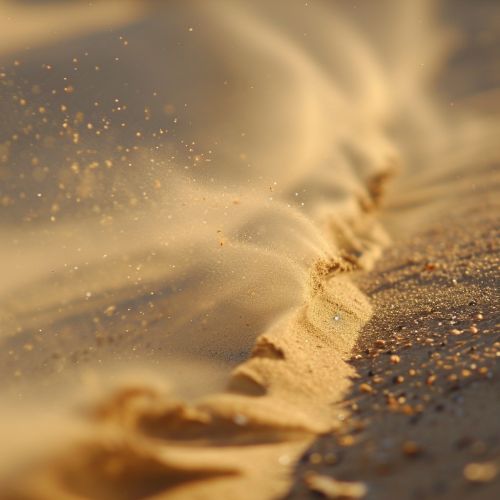Saltation (geology)
Introduction
Saltation is a term derived from the Latin word 'saltus', meaning 'to leap'. In the field of geology, it refers to the transportation of small particles by wind or water in a series of short, intermittent jumps. This process is a crucial component of erosion and sediment transport, shaping landscapes and contributing to the formation of various geological features.


Process of Saltation
Saltation occurs when the force of wind or water is strong enough to lift small particles, such as sand or silt, but not strong enough to keep these particles in suspension. The particles are lifted from the surface, move in a trajectory determined by the velocity and direction of the wind or water, and then fall back to the ground. The impact of these particles can dislodge other particles, causing them to begin saltating as well. This process is a primary mechanism of particle transport in both aeolian (wind-driven) and fluvial (water-driven) environments.
Factors Influencing Saltation
Several factors influence the process of saltation, including the size, shape, and density of the particles, the roughness of the ground surface, and the velocity and direction of the wind or water. For instance, smaller and lighter particles are more easily lifted and transported than larger, heavier ones. Similarly, a smooth surface allows for easier particle movement than a rough one. The velocity and direction of the wind or water also play a significant role, with higher velocities and more direct angles of impact leading to more intense saltation.
Saltation in Aeolian Environments
In aeolian environments, such as deserts and beaches, saltation is a key process in the formation of sand dunes and other wind-blown geological features. The wind lifts sand particles into the air, where they are carried forward before falling back to the ground. The impact of these particles can cause other particles to be lifted, creating a chain reaction. Over time, this process can lead to the formation of large sand dunes and other aeolian landforms.
Saltation in Fluvial Environments
In fluvial environments, such as rivers and streams, saltation contributes to the erosion of the riverbed and the transport of sediment downstream. Water flow lifts sediment particles into the current, where they are carried downstream before falling back to the riverbed. The impact of these particles can dislodge additional sediment, contributing to further erosion and sediment transport. Over time, this process can lead to significant changes in the shape and course of the river or stream.
Impact on the Environment
Saltation has a significant impact on the environment, contributing to the shaping of landscapes and the formation of various geological features. It also plays a role in the distribution of nutrients and minerals in soils, the erosion of coastlines, and the formation of sand dunes and other aeolian landforms. In addition, saltation can contribute to air pollution, as dust and other small particles are lifted into the air and carried by the wind.
